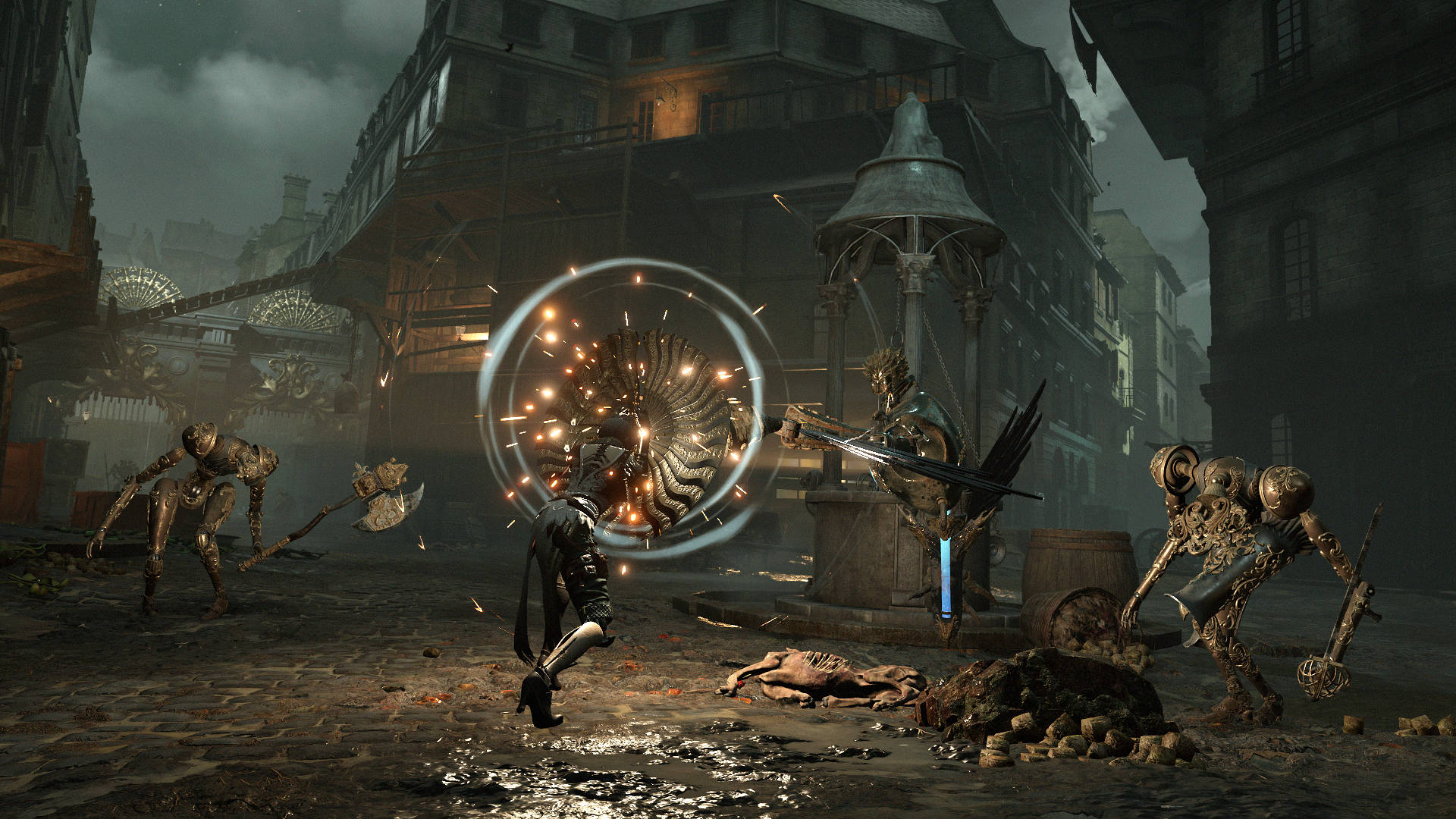Steelrising Review
There’s long been a trend in cinema where two movies will come out in close proximity that both touch upon surprisingly similar subjects. We’ve seen pairings such as Deep Impact and Armageddon, Turner & Hooch and K-9, and Olympus Has Fallen and White House Down. Right now, over here on the gaming side of the tracks, we’re experiencing our own such phenomenon, as two new Souls-likes look to tackle the idea of an automaton hero taking on an evil clockwork army in a dark and twisted version of a past era: Spiders’ Steelrising and Round 8 Studio’s Lies of P.
In contrast to the tale of a weirdly hot robot Pinocchio living out a reminaging of an Italian children’s novel, Steelrising pulls from the real-life French Revolution. Here, King Louis XVI attempts to quell an uprising of the people using an army of robots created by Eugène de Vaucanson, the fictional nephew of French inventor and artist Jacques de Vaucanson (a pioneer in the world of early automata). As the King’s machines rampage across Paris, there’s only one being that can stop them: Aegis, a fellow android that currently serves as a bodyguard to Queen Marie Antoinette. With her mistress concerned about the actions of the King, Aegis heads out to learn more about what’s going on and try to put a stop to the madness.
From the beginning, Aegis is an interesting character, and she plays into a concept I’ve long found fascinating: the hero who came to exist primarily as a tool for humanity, but who then rises above humans to become their savior. (It doesn’t hurt that I finally watched Blade Runner 2049 recently, which touches on some similar topics.) At first, her interactions with NPCs in Steelrising are borderline comical, as pretty much every encounter runs through the same cycle: Aegis tries to speak to someone, they assume she’s a death machine, she explains that she’s out on orders from the Queen, and then said person suddenly has a change of attitude and begs for help.
The deeper we get into the game, the richer Aegis’ personality becomes, yet that happens without the developers ever feeling the need to make her too human. She has a few moments of real emotion that I can’t speak to more without getting into spoiler territory, but I quite enjoyed getting to play as a character that has a voice (figuratively and literally) and involvement in what’s happening while also feeling like more of an observer to the human drama that’s going on rather than a full participant. As someone who often gets too emotionally involved with making choices in narrative games, it was a nice break to get to commit to decisions while also kinda not caring about the messes those fleshbags were getting themselves into. Let me have cake, and eat it too.
We also see Aegis grow as a character on a gameplay level. When Steelrising kicks off, our heroine really isn’t that much of a bodyguard, as her stats are pretty low and her abilities very simple when it comes to Souls-likes. After felling the first handful of bosses, the game offers up three upgrades which make Aegis less clunky in both combat and exploration: a grappling hook that can also deal electrical damage, a ground/air dash that builds up an enemy’s frost status when hit, and a powerful kick that can both destroy obstacles and set foes alight.
Steelrising initially promises a wide array of weapons for players to experiment with, but the reality is that there’s a core selection of armament types that then shuffle their special moves and elemental affinities to create more variety. The thing is, I never felt like I had all that much choice in what to wield, at least in the way I approached the game. Early on, I was swapping between the Armored Fans, Fire Chain, Shield Musket, and Wheel of Vengeance (a giant pocket watch that swings very slowly yet hits very hard). However, thanks to one boss in particular, it soon seemed illogical to go with anything other than a weapon that features the ability to counterattack. If I really needed to do elemental damage, Aegis’ upgrades were always there, and maybe I just don’t know how to use it right, but Steelrising’s block (for those arms that offer it) feels almost useless. Being able to parry most of the attacks enemies would throw at me, and then get in extra hits in return, was just far too powerful an option to ever consider swapping out.
My lack of enthusiasm over weapon selection would lead to a bigger realization I had about why Steelrising just wasn’t sitting right with me early on: This is a game that seems to take inspiration from Dark Souls—as in, the original Dark Souls—when we’re now living in a post-Elden Ring world.
Now, I want to be clear: I’m directly comparing Spiders’ latest release to FromSoftware’s groundbreaking action RPG because such comparisons are absolutely going to happen, fair or not, given the games launched mere months apart. In that, it just feels like some of the ideas here are now clearly outdated. The treacherous and/or lengthy runs back to bosses and the emphasis on backtracking-laided exploration due to a lack of fast travel are a few examples. This isn’t just an issue when comparing Steelrising directly to Elden Ring, but also when looking toward older games such as Dark Souls III or Bloodborne, where FromSoftware was already moving past some of the ideas it had helped to popularize.
In fairness, on the other side of the argument, there are a few neat touches here that offer new twists on old Souls ideas. One is the Endurance system, which acts as your typical stamina bar, governing how many attacks or other actions Aegis can unleash before needing to let the bar refill. When that bar is completely drained, you can use a special Rapid Cooling option to quickly recharge Aegis’ Endurance at the cost of giving her some amount of frost ailment. Use Rapid Cooling too often, or use it when fighting an enemy that can also proc frost, and you could find yourself temporarily unable to move. I’m sure I’m forgetting some other Souls-like out there that offers up a similar system, but it’s a neat risk-reward feature that feels appropriate to the setting. Spiders also gives us a pretty fantastic Assist Mode for players who might need help during the game, where you can: reduce the damage you take (even down to 0%); set it to not drop your anima (aka souls) upon death; increase stamina regeneration (up to 300%); or activate easier cooling. I honestly didn’t try these for myself, out of fear of it negating my chance to get certain achievements, but I really appreciate that Assist Mode is there for those who might want it.
Steelrising is absolutely not a game I’d call bad or even average, and it certainly is far from the weakest Souls-like I’ve played over the years. And, as the game goes on, some of its rough patches smooth out, while other quirks just become part of the experience. It’s just, I wish Spiders had focused more on its own blend of action gameplay rather than copying off FromSoftware’s work, even if the result had come along with more jank. Or—dare I say it—I maybe wish Steelrising had been less Dark Soulsand more Nier: Automata. Having the game’s enemies be big, clunky, and awkward when moving or attacking makes sense, but given Vaucanson built Aegis primarily to be a dancer, it’d have been more fitting (and potentially more fun) to have her contrast them by being nimble and graceful in her attacks.
Another reason I wish the team had followed its own path more is that the narrative feels far more in line with Spiders’ previous works—and that’s the side of Steelrising that makes it stand out the most. Now, as your typical American who went through the public school system, I barely know my own country’s history, let alone that of some strange foreign land like France. So, I’m not too proud to admit that when the game was talking about the Estates General or the Tennis Court Oath or asking me to keep track of people like Maximilien Robespierre and Jean-Sylvain Bailly, my Aegis was just smiling and nodding along like she actually knew what was going on.
That’s part of the game’s charm, though: just how unapologetic and unafraid it is to dive into real-world 18th century French history in between asking me to fight murderbots. Maybe I’m too used to experiencing world history from a Japanese lens, where warships become teenage girls or records show George Washington punching tigers, but you’ve gotta respect how serious Spiders treats its home country’s past here. Well, except for the inexcusable decision to not give us a French-language audio track. Playing A Plague Tale: Innocence in the game’s mother tongue was a joy for me, and to not have the same option here feels like a huge oversight.
In the end, I think Steelrising is a decent new release that stumbles somewhat by trying to emulate the cool kids instead of just being its own person… er, robot… er, game. When looked at simply as a Souls-like, it’s definitely good, but it also certainly could have been better. As a complete experience when factoring in the characters, storyline, and other elements, however, it eventually grows into something that’s genuinely unique and respectable. I don’t know that I’d want a sequel to Steelrising—because it doesn’t really need one—but if one does come, I’d rather Spiders find its own voice when crafting the gameplay, rather than trying harder to mimic or enhance someone else’s.
Steelrising
Summary: Steelrising is a new Souls-like twist on the French Revolution that unfortunately doesn’t see all of its lofty ambitions grow into accomplishments. While its gameplay is enjoyable once you get far enough to earn some unlocks and get main character Aegis more decked out, it tries to mimic elements of FromSoftware’s action RPG classics without always understanding what made said elements work. When Spiders leans less on taking inspiration from other games and more on presenting its own ideas, however, we get an intriguing—and surprisingly deep—alternate take on an important moment in France’s history.
Score: -
Steelrising was reviewed using review code, physical copies, or hardware provided by Nacon. Scores are graded on a scale of E (Bad) to S (Special) in homage to Japanese video game grading scales, with the understanding that an S still does not denote a "perfect" score. Scores may have been adjusted from the original source to better fit my personal scale.




